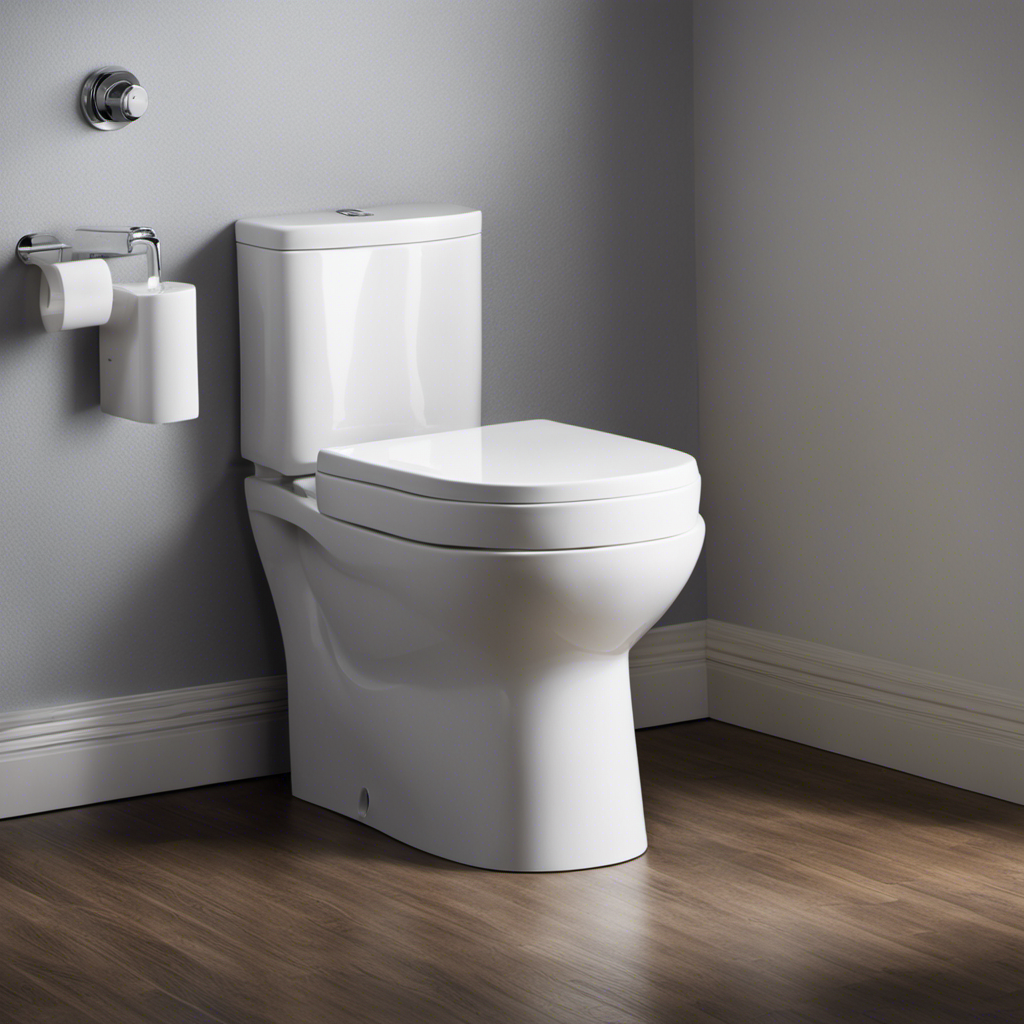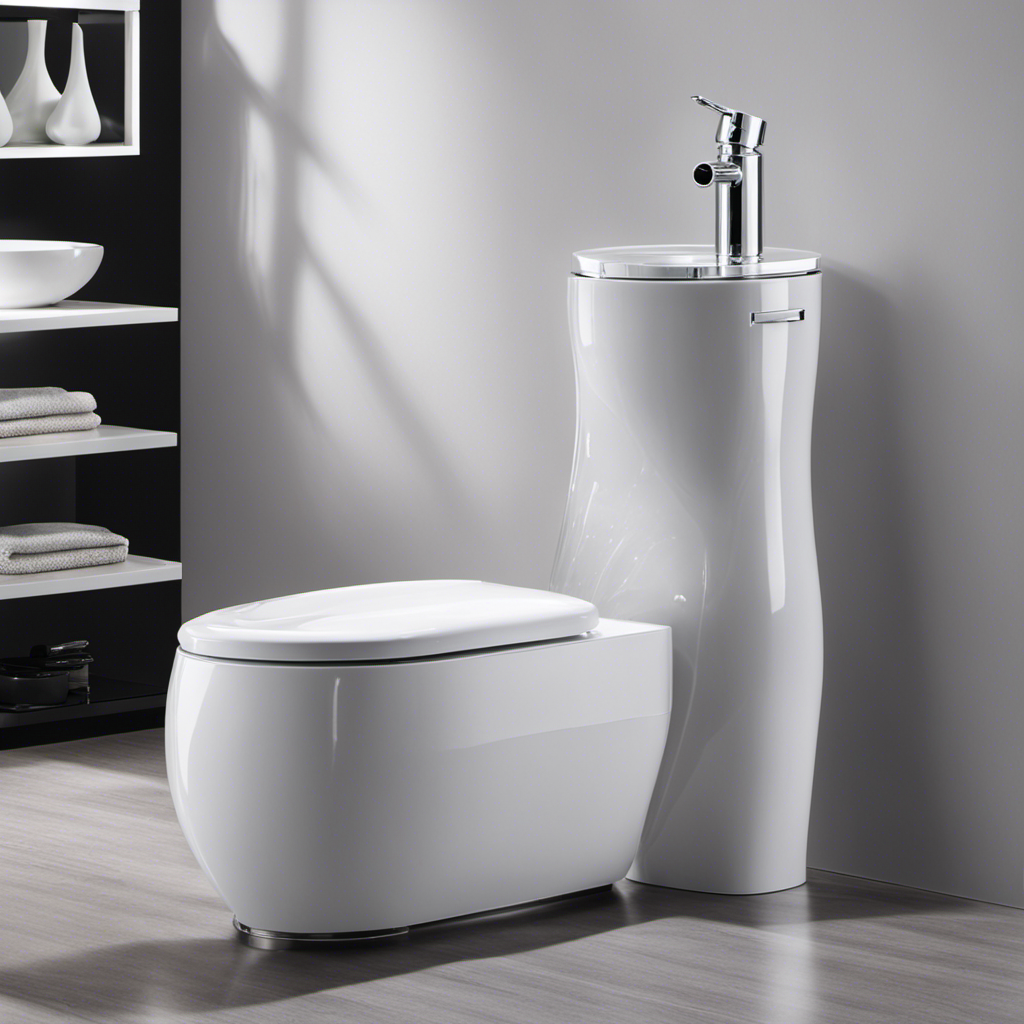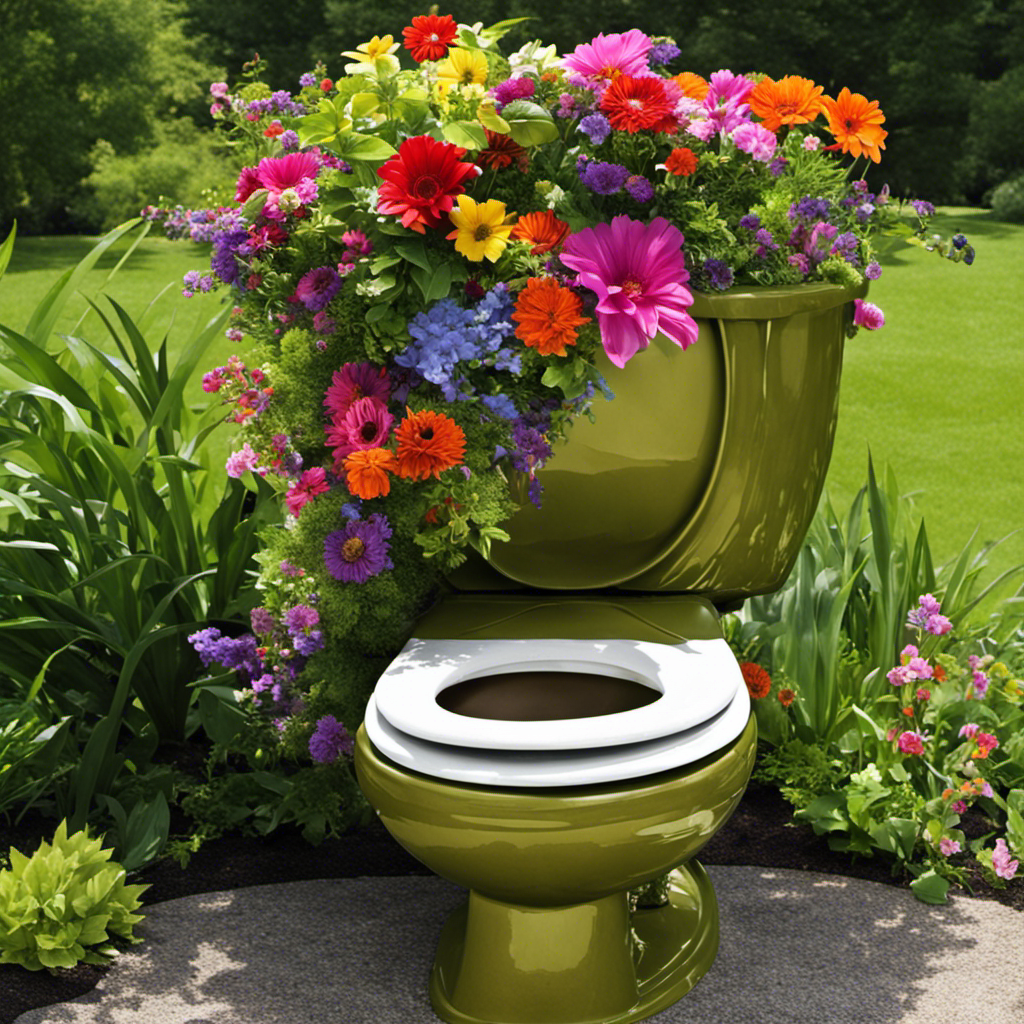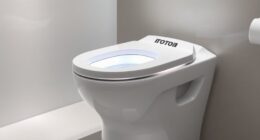I’ve always wondered why there’s a sudden spray of water when I flush the toilet. It’s a strange phenomenon that often goes unnoticed, but it can have a significant impact on hygiene.
In this article, I’ll delve into the causes of toilet spray, its implications on cleanliness, and provide tips on how to prevent it. Additionally, I’ll share effective cleaning methods and DIY solutions that you can try.
So, let’s dive in and tackle this pesky issue together!
Key Takeaways
- Toilet spray is caused by the high-pressure environment created during flushing, which forcefully pushes against residual waste and toilet spray chemicals.
- Toilet spray can contain harmful bacteria and microorganisms, emphasizing the importance of maintaining good hygiene practices in the bathroom.
- The design and shape of the toilet bowl, as well as the water level in the tank, can contribute to the occurrence of toilet spray.
- Regular cleaning and disinfection of surfaces, proper ventilation system maintenance, and considering professional help can help prevent and address toilet spray issues, reducing the risk of contamination and the spread of infectious diseases.
Understanding Toilet Spray
I’m not sure why toilet spray happens when flushing. However, I can provide some technical insight into this phenomenon.
When you flush a toilet, a mechanism activates to release water from the tank into the bowl. This sudden rush of water creates a high-pressure environment inside the bowl. As a result, the water forcefully pushes against any residual waste and toilet spray chemicals present in the bowl. The force of the water can cause these particles to become aerosolized, resulting in toilet spray.
This spray can contain bacteria and other harmful microorganisms, which is why it is important to maintain good hygiene practices in the bathroom.
Now that we understand the mechanism behind toilet spray, let’s explore the causes of this issue.
Causes of Toilet Spray
You can reduce the likelihood of water splashing out of the bowl by adjusting the water level in your toilet tank. Understanding the causes of toilet spray is essential for preventing contamination.
One of the main causes is a high water level in the tank, which creates excessive pressure during flushing. This pressure can result in water forcefully splashing out of the bowl.
Another cause is a clogged or partially blocked toilet trap or drain. This obstruction can disrupt the normal flow of water, causing it to splash back.
Additionally, the design and shape of the toilet bowl can also contribute to spray. To prevent contamination, it is important to regularly check and adjust the water level in the tank, ensure proper toilet maintenance, and consider installing a toilet with a design that minimizes splash.
Impact of Toilet Spray on Hygiene
When it comes to maintaining hygiene, one important aspect to consider is the presence of airborne particles. These particles can easily become contaminated and contribute to the spread of infectious diseases.
Therefore, it is crucial to implement effective cleaning methods that can effectively eliminate these particles and minimize the risk of contamination and spread.
Hygiene and Airborne Particles
Airborne particles can contribute to the spread of germs and affect overall hygiene. One significant source of airborne particles in indoor spaces is ventilation systems. These systems play a crucial role in maintaining air quality and preventing respiratory illnesses. However, if not properly maintained, they can become breeding grounds for bacteria and mold, which can then be dispersed into the air. This is why regular cleaning and maintenance of ventilation systems are essential. By removing dust, debris, and contaminants from the system, the risk of airborne particles and subsequent health issues can be significantly reduced. Additionally, proper filtration systems can further help in trapping these particles and preventing their circulation in the indoor environment. Maintaining clean and well-functioning ventilation systems is vital for ensuring a healthy and hygienic indoor environment.
| Ventilation Systems | Importance |
|---|---|
| Regular maintenance | Reduces risk of airborne particles |
| Proper cleaning | Prevents the spread of germs |
| Effective filtration | Traps contaminants for improved air quality |
Contamination Risks and Spread
Contaminated surfaces can easily contribute to the spread of germs and should be regularly cleaned and disinfected. When it comes to airborne bacteria, the health implications can be significant.
One particular source of airborne bacteria is the toilet spray that occurs when flushing. This spray can contain a variety of microorganisms, including bacteria and viruses, which can then settle on nearby surfaces. If these surfaces are not properly cleaned and disinfected, the bacteria can survive for extended periods and potentially cause infections.
Some common health implications of exposure to these airborne bacteria include respiratory infections, gastrointestinal illnesses, and skin infections.
To minimize the risk of contamination, it is important to regularly clean and disinfect commonly touched surfaces, especially those in close proximity to toilets.
Effective Cleaning Methods
To effectively clean and disinfect surfaces, you should use appropriate cleaning products and follow recommended guidelines. When it comes to preventing toilet spray, there are a few natural cleaning solutions that can be effective.
One such solution is a mixture of vinegar and water. Vinegar is known for its antimicrobial properties and can help kill germs and bacteria on surfaces. Simply mix equal parts vinegar and water in a spray bottle and use it to clean the toilet seat, handle, and surrounding areas.
Another natural option is tea tree oil. This essential oil has antibacterial and antifungal properties. Mix a few drops of tea tree oil with water in a spray bottle and use it to wipe down surfaces.
These natural cleaning solutions can help prevent the spread of germs and keep your bathroom clean and safe.
Now, let’s move on to some tips to prevent toilet spray.
Tips to Prevent Toilet Spray
When it comes to preventing toilet spray, two key factors to consider are proper seat positioning and quick flush techniques.
First, ensure that you are sitting on the toilet seat in the correct position, with your buttocks positioned at the back of the seat and your thighs parallel to the ground. This will help create a seal between your body and the seat, minimizing the chances of any spray escaping.
Secondly, adopt quick flush techniques that involve pressing the flush lever or button swiftly and firmly, allowing for a powerful flush that effectively carries away any waste and reduces the likelihood of spray.
Proper Seat Positioning
Make sure you’re sitting in the correct position on the toilet seat to avoid any unnecessary mess. Proper seat positioning is crucial in preventing splashes and keeping your bathroom experience clean and hygienic.
To achieve the best seat positioning, follow these guidelines:
- Sit towards the back of the seat, ensuring your buttocks are fully supported.
- Keep your thighs parallel to the ground, with your feet flat on the floor.
- Lean slightly forward to maintain a good posture and prevent any contact between your body and the inside of the toilet bowl.
By adopting this proper seat positioning, you can minimize the risk of splashes during flushing.
Quick Flush Techniques
Remember, it’s important to press the flush lever firmly for a quick and efficient clean.
When it comes to flushing a toilet, using a quick flush technique can offer several benefits, including reducing toilet spray. By activating a powerful flush, you can minimize the amount of water in the bowl during the flush, resulting in less splashback and spray. This is especially useful in public restrooms where hygiene is crucial.
Quick flushes help to prevent bacteria and germs from being dispersed into the air, keeping the surrounding area cleaner and healthier. Additionally, reducing toilet spray can also contribute to a more pleasant restroom experience for everyone.
Effective Cleaning Methods for Toilet Spray
To effectively clean toilet spray, you should consider using a mixture of vinegar and baking soda. This natural cleaning solution is not only effective in removing stubborn stains and odors but also helps in preventing toilet spray from occurring in the first place.
Here are some key steps to follow for a thorough cleaning:
- Start by pouring a cup of vinegar into the toilet bowl.
- Let it sit for a few minutes to allow the vinegar to break down any buildup.
Next, sprinkle baking soda over the vinegar and let it fizz.
Scrub the toilet bowl using a toilet brush, paying extra attention to the areas where spray tends to accumulate.
Finally, flush the toilet to rinse away the mixture and enjoy a clean and fresh-smelling bathroom.
DIY Solutions for Toilet Spray
After exploring effective cleaning methods for toilet spray, let’s now delve into DIY solutions for tackling this issue.
If you prefer natural remedies, there are several DIY sprays you can create at home to help eliminate unpleasant odors and reduce toilet spray.
One option is to mix equal parts distilled white vinegar and water in a spray bottle. Vinegar has natural disinfecting properties and can help neutralize odors.
Another option is to combine baking soda and water to create a paste, which can be applied to the inside of the toilet bowl and left for a few minutes before scrubbing with a toilet brush. Baking soda is known for its deodorizing abilities.
These DIY sprays offer a cost-effective and environmentally friendly alternative to commercial cleaners. However, if the toilet spray problem persists despite your efforts, it may be time to seek professional help.
Seeking Professional Help for Toilet Spray
If the issue persists, it might be a good idea to consider seeking professional help for your toilet spray problem. When it comes to toilet spray prevention, professional cleaning services can offer effective solutions.
Here are some reasons why hiring professionals can be beneficial:
-
Expertise: Professional cleaners have the knowledge and experience to identify the root cause of the toilet spray and provide appropriate solutions.
-
Specialized equipment: They have access to advanced tools and equipment that can effectively clean and sanitize your toilet, eliminating any lingering odors.
-
Time-saving: Hiring professionals saves you time and effort, as they can efficiently tackle the problem and ensure your toilet is thoroughly cleaned and maintained.
Frequently Asked Questions
Can Toilet Spray Be Harmful to Our Health?
Inhaling toilet spray may have health implications due to potential exposure to bacteria and harmful chemicals. Additionally, the environmental impact of toilet spray usage should be considered, as it contributes to water pollution and may disrupt ecosystems.
Can Toilet Spray Lead to the Spread of Diseases or Infections?
Toilet spray, while helpful in reducing airborne particles, is not as effective as handwashing in preventing the spread of diseases or infections. It is crucial to prioritize proper hygiene practices for optimal health and safety.
Are There Any Specific Demographics That Are More Susceptible to Toilet Spray?
There are no specific demographics that are more susceptible to toilet spray. However, it is important to implement toilet spray prevention methods to minimize the impact of toilet spray on indoor air quality.
Can Toilet Spray Cause Damage to Bathroom Surfaces or Fixtures?
Toilet spray can potentially damage bathroom surfaces and fixtures due to the corrosive nature of the water and waste particles. It is important to consider using toilet spray alternatives and implementing preventive measures to minimize this risk.
Can Using a Bidet or Wiping With Wet Wipes Reduce Toilet Spray?
Using a bidet or wet wipes can reduce toilet spray. Bidets have benefits like thorough cleansing and reducing paper waste. Wet wipes are effective for cleaning, but be mindful of their impact on the environment.
Conclusion
In conclusion, it’s crucial to address the issue of toilet spray to maintain proper hygiene in our bathrooms.
By understanding the causes of toilet spray and implementing preventive measures, we can effectively minimize the spread of bacteria and unpleasant odors.
Regular cleaning using effective methods and DIY solutions can also help in combating this problem.
However, if the issue persists, it’s advisable to seek professional help to ensure a clean and fresh bathroom environment.
Just like a vigilant guardian, let’s keep our toilets free from the uninvited spray and maintain a pristine space for our personal hygiene.









